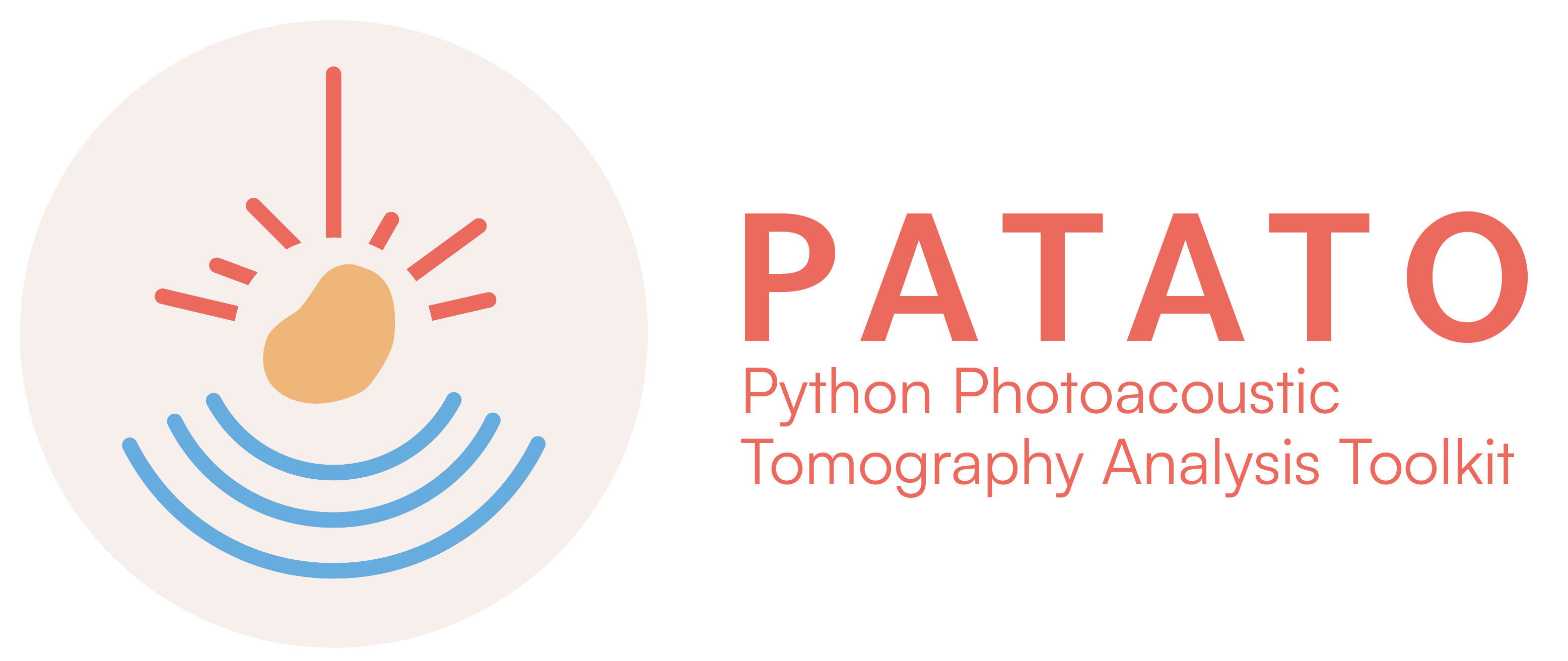Image Processing Parameters#
The default image processing pipeline is as follows:
The dataset is converted from the original format into a PATATO HDF5 file (for example from the iThera format).
patato-import-ithera /path/to/ithera/study/folder /path/to/data/folder
For the iThera importation, pass in the study folder, which contains Scan_1, Scan_2 etc. All of these will be processed, producing Scan_1.hdf5, Scan_2.hdf5 etc in the data folder.
The speed of sound is set for each scan.
patato-set-speed-of-sound /path/to/data/folder 1500
The image reconstruction algorithm is applied to each scan.
patato-reconstruct /path/to/data/folder
Spectral unmixing can be applied.
patato-unmix /path/to/data/folder
Regions of interest can be drawn over the images for further analysis.
patato-draw-roi /path/to/data/folder
Time series analysis can be applied.
patato-analyse-gc /path/to/data/folder --display True
patato-analyse-dce /path/to/data/folder --display True
Further analysis can be done in Python (see examples).
>>> import patato as pat
>>> dataset = pat.PAData('/path/to/data/folder/Scan_x.hdf5')
>>> dataset.set_default_recon()
>>> dataset.get_scan_reconstructions().imshow()
Reconstruction Preset Parameters#
Reconstruction parameters can be controlled by passing in –preset. The default preset is a good starting point for most basic applications. It does a backprojection with a Hilbert transform. If a json file is passed in as a preset, you can control the reconstruction parameters. For example, you can change the band-pass filter, remove the Hilbert transform, change the pixel size, or use a Model-Based algorithm (implementation in progress).
{
"FILTER_HIGH_PASS": 5e3, // High pass filter in Hz
"FILTER_LOW_PASS": 7e6, // Low pass filter in Hz
"IRF": true, // Whether to do impulse response correction
"HILBERT_TRANSFORM": true, // Whether to do a Hilbert Transform
"INTERPOLATE_TIME": 3, // Interpolate the time axis by this factor
"INTERPOLATE_DETECTORS": 2, // Interpolate the detector axis by this factor
"PREPROCESSING_ALGORITHM": "Standard Preprocessor", // Which preprocessing algorithm to use
"RECONSTRUCTION_FIELD_OF_VIEW_X": 0.024975, // Field of view in x in metres
"RECONSTRUCTION_FIELD_OF_VIEW_Y": 0.024975, // Field of view in y in metres
"RECONSTRUCTION_FIELD_OF_VIEW_Z": 0., // Field of view in z in metres - ignored when RECONSTRUCTION_NZ is 1
"RECONSTRUCTION_NX": 333, // Number of pixels in x
"RECONSTRUCTION_NY": 333, // Number of pixels in y
"RECONSTRUCTION_NZ": 1, // Number of pixels in z
"RECONSTRUCTION_PARAMS": {}, // Extra parameters for the reconstruction algorithm
"RECONSTRUCTION_ALGORITHM": "Reference Backprojection" // Which reconstruction algorithm to use
}
Unmixing Preset Parameters#
Unmixing parameters can also be controlled by passing in –preset. By default, the unmixing is done with Oxyhaemoglobin and Deoxyhaemoglobin basis spectra. To unmixing for different chromophores, pass in a json file as a preset.
{
"RESOLUTION_REDUCE": 3, // The factor by which to reduce the resolution of the reconstruction to improve SNR
"WAVELENGTH_RANGE": [700, 900], // The wavelength range to use for unmixing
"SPECTRA": ["Hb", "HbO2"], // The chromophores to use as basis for unmixing. Could also add "ICG".
"SO2": true, // Whether to calculate sO2 after unmixing
"SUFFIX": "" // What label to give the unmixing with this preset (e.g. ICG) - this allows you to make sure that
// you use the correct unmixing in your analysis. It makes no difference to the actual algorithm.
}
